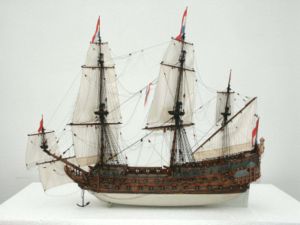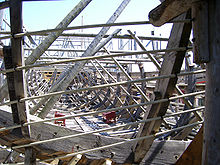- Dutch ship De Zeven Provinciën (1665)
-

Model (scale 1:87) of De Zeven Provinciën, built by Herbert Tomesen for the Bataviawerf in the NetherlandsCareer (Dutch Republic) 
Name: De Zeven Provinciën Builder: Jan Salomonszoon van den Tempel, Rotterdam Fate: Broken up in 1694 General characteristics Class and type: 57-gun ship of the line Length: 151 ft (46 m) (gundeck) Beam: 40 ft 6 in (12.34 m) Depth of hold: 15 ft (4.6 m) Propulsion: Sails Sail plan: Full rigged ship Armament: 80 guns (later 76 guns):
- Gundeck: 12 × 36 pdrs, 16 × 24 pdrs (later 28 × 36 pdrs)
- Upper gundeck: 14 × 18 pdrs, 12 × 12 pdrs
- Quarterdeck, Forecastle & Poop deck: 26 × 6 pdrs
For other ships of the same name, see HNLMS De Zeven Provinciën.De Zeven Provinciën was a Dutch ship of the line, originally armed with 80 guns. The name of the ship was also written as De 7 Provinciën. The literal translation is "The Seven Provinces", the name referring to the fact that the Dutch Republic in the 17th century was a confederation of seven autonomous provinces. The vessel was originally built in 1664-65 for the Admiralty of de Maeze in Rotterdam, by Master Shipbuilder Salomon Jansz van den Tempel.
The ship served as Admiral Michiel de Ruyter's flagship during the Second Anglo-Dutch War, taking part in the hard fought Dutch victory in the Four Days Fight, the bitter defeat at the St. James's Day Battle, and acting as a command post as well as blockading the Thames during the Raid on the Medway. The vessel gave a good account of itself throughout the war, although it was partially dismasted during the Four Day's Fight.
De Ruyter used De Zeven Provinciën as his flagship during the Third Anglo-Dutch War of 1672-1673. The ship served in all four major battles against the combined English and French fleet, fighting in the Battle of Solebay, the first and second Battle of Schooneveld and, in possibly its greatest moment, at the Battle of the Texel.
In 1692, the ship, now armed with only 76 guns, fought at the Battles of Barfleur and La Hogue during the War of the Grand Alliance. The vessel was severely damaged during the fight and, in 1694, De Zeven Provinciën had to be broken up.
De Zeven Provinciën measured, in English Feet, approximately 151 ft long by about 40 ft (12 m) wide by a little over 15 ft (4.6 m) deep. It was originally armed with 12 36-pdrs and 16 24-pdrs on the lower deck (although this had been changed to an all 36-pdr battery by the time of the Third Anglo-Dutch War), 14 18-pdrs and 12 12-pdrs on the upper deck, and 26 6-pdrs on the forecastle, quarterdeck, and poop deck.
 The construction of a ship replica of De Zeven Provinciën
The construction of a ship replica of De Zeven Provinciën
In 1995 a full-size replica of the ship was started at the Batavia-werf (docks) in Lelystad; but due to heavy technical problems that work was completely wrecked. As of 2008, a new replica is being constructed.
On the evening of October 13, 2008 a fire ripped through the Batavia-werf. Although the sailmaking shed, several office buildings and part of a restaurant were destroyed, as were the sails of fellow replica ship Batavia, the replica of "De Zeven Provinciën" nearby was undamaged.
References
- Ships 1660-1669 Sailing Warships. Retrieved 2 December 2007.
- De 7 Provincien (Dutch). Bataviawerf - Nationaal Scheepshistorisch Centrum. Retrieved 2 December 2007.
Categories:- Ships of the line of the Dutch Republic
- Replica ships
- 1660s ships
Wikimedia Foundation. 2010.
